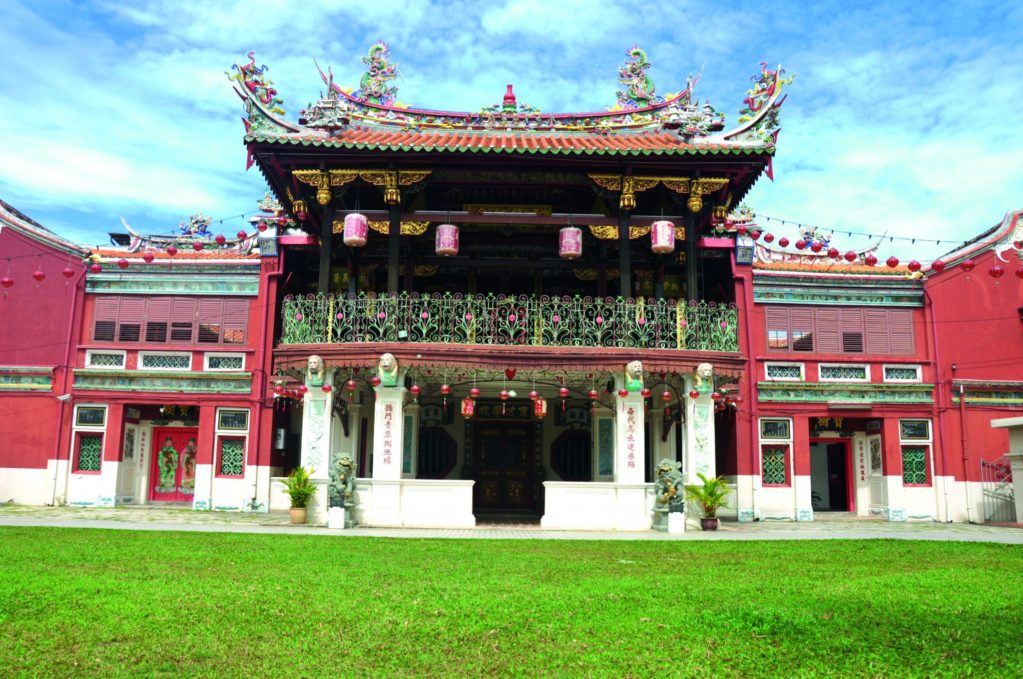If you want to blend with the people, you’d better learn the word ‘Lah’. I mean it-lah. ‘Lah’ is the backbone of Malaysian slang, while the suffix has no standard meaning it’s used colloquially to express emphasis.
You can get to Palau—meaning ‘island’ in Malay—Penang, off the north-western coast of the peninsula by airplane, ferry or bus, over Malaysia’s longest bridge. It is not your typical tropical island. Yet it is home to Georgetown: a UNESCO World Heritage Site and the historical capital of Penang.

Trishaw Drivers outside Stadyhuys in Melaka
Along the neighborhood’s streets you’ll find quaint cafés, antique stores and narrow alleys which lead to hidden Buddhist temples; yet the highlight is Khoo Kongsi. This walled-off Chinese district was home to the powerful Khoo clan. By the 19th century they were a self-governing community with their own education, financial, welfare and social organizations.
With short distances between the historical landmarks of the colonial district—Fort Cornwallis, City Hall and Victoria Memorial Clock Tower—it is best explored on foot.
The indigo blue Cheong Fatt Tze mansion, which was built in the 1880s and restored more than 100 years later, provides a glimpse into the lifestyle of the Chinese businessman by the same name. You can call this heritage hotel your home during your stay, otherwise take a daily tour.
Take a break from sightseeing by having Cendol for dessert. The green, jelly noodles, made from rice flour, swim in coconut milk and are topped with shaved ice and palm sugar. And for dinner try some Nyonya cuisine, for which the island is well-known: a combination of Chinese ingredients fused with Southeast Asian spices like lemon grass, turmeric, chillies and, of course, coconut milk.
On your way south, go on an eco-tourism jungle trek in the tropical rainforests of the Cameron Highlands, in search of the world’s largest flower, the Rafflesia. Nestled in Pahang province, it’s the ideal retreat for avid hikers, tea-lovers and those who prefer cooler climes.
The capital, Kuala Lumpur (KL), is synonymous with the Petronas Towers, which balance on Kuala Lumpur City Center Mall. If you arrive early, you might get a free, limited ticket for skybridge—on the 41st floor, 170 meters above ground—but expect to wait in line. Kuala Lumpur Tower offers splendid views of the Petronas Towers.
A typical feature of Malaysian colonial cities is an open playing field surrounded by public buildings. Kuala Lumpur is no exception. Merdeka Square, which used to be a cricket field, is where Malaysia’s independence from Britain was announced on August 31, 1957.

Penang City Hall
Getting around by train can be mind boggling because the train systems are like a labyrinth. Once you decipher the metal maze of the KL Monorail, KLIA Ekspres and transit, Light Rail Transit and KTM Komuter trains, you’ll be on your way.
Further north from the capital are the Hindu temples in the Batu Caves, located in a limestone hill. You’ll have to climb 272 stairs to reach them, although the greatest attraction is the world’s largest statue—42 meters high—of Murugan, a Hindu deity, which is painted gold. And just south of the city, on the banks of Putrajaya Lake, is Putra Mosque, near the prime minister’s offices.
You can’t afford to miss out on visiting Melaka, on the southern coast: my personal favorite. The colonial history of Southeast Asia’s greatest trading port is visible at every corner. Take a trishaw—decorated with plastic flowers, Barbie dolls, rainbow-colored fans—trip around the most important historical and cultural landmarks from the red Stadthuys (town square), through Chinatown and Little India to Jonker Walk, where the night life and shopping can be found. The government employed artists to rejuvenate the buildings along the canal.
The Perhentian islands, on the north-eastern coast, are celebrated by tourists for their azure waters and palm-fringed white beaches. Scuba diving by the coral reefs, snorkeling and swimming are the best ways to spend your days. You can do some turtle or shark watching too, but the best thing to do here is, well…nothing. This is a place for the beach and a book. High season is from May to September, the islands are closed during monsoon season, from mid-November to mid-February.

The Petronas Towers in Kulula Lumpur
Download e-travel guides for the entire country at www.tourism.gov.my.
